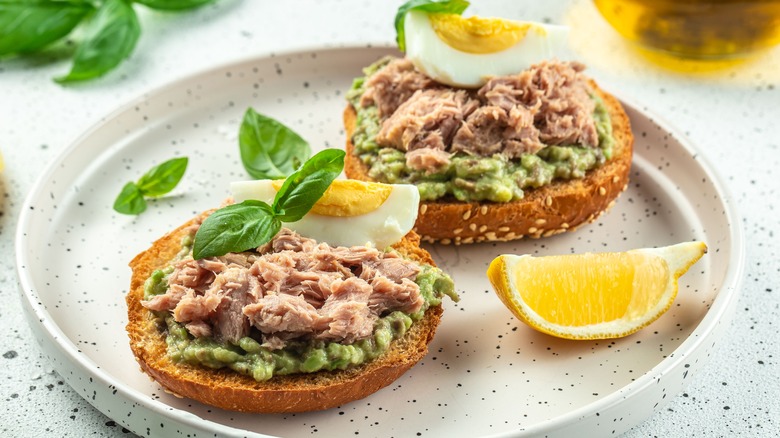Is Canned Tuna Cooked Or Raw?
Whether eaten as-is or mixed into a canned tuna sushi bake, canned tuna appears in a wide array of hot and cold dishes. A can of tuna is among the most affordable and nutritious proteins available to consumers, making it an easy choice for a quick lunch or dinner. But the degree to which people of all ages and income levels reach for canned tuna begs the question: Is it safe right out of the can — or is it raw?
Canned tuna sold in U.S. supermarkets requires no refrigeration and must be sold ready-to-eat, according to guidelines set by the National Fisheries Institute's Tuna Council. All tuna that is sold in cans or pouches in grocery stores undergoes a cooking process to preserve the freshness of the fish and ensure its longevity in the sealed container. Often, that tuna is actually cooked twice: once before canning and once after — just to be sure all bacteria is really killed. No matter what your can of tuna is packed in, from brine to oil, you can rest assured that it's perfectly fine to eat right out of the can.
Canned tuna is safe for immediate consumption
As outlined by the Tuna Council, tuna designated for sale in cans goes through a thorough sequence of processing to make sure it can be eaten by consumers fully cooked from the can. Tuna is delivered to canning facilities either directly from fishing ships or from vessels that deliver from them. Most of the tuna is delivered frozen and will be moved into cold storage at the canning facility. Producers then thaw and cook the fish — either whole or in pieces, depending on its size. During the butchering phase, manufacturers separate the tuna meat and designate it for consumption by either humans or pets.
Once the tuna has cooled, producers clean and separate the flesh from any skin, bone, or other undesirable components. Once the cleaned tuna meat is isolated, it moves onto the final canning where it is packed with liquid like a saltwater brine or oil, as well as any additional spices or seasonings the manufacturer might want to add. Once filled, the cans are vacuum sealed to ensure freshness — and are then further sterilized before moving onto packing and distribution.
Popular types of canned tuna and canned tuna recipes
In the U.S., most canned tuna meat comes from two main species of fish: skipjack and albacore. Skipjack tuna, commonly sourced from the Atlantic, has a light and flaky texture, which lends itself easily to canning. Its flavor can be described as characteristically fishy and is often labeled as "chunk light tuna" when canned. Albacore tuna has both Atlantic and Pacific varieties, with a firm texture; its flavor is milder, and it's the only canned tuna that can be labeled as "white meat."
Whether you are working with a flaky can of chunk light tuna or a more dense and rich albacore, canned tuna offers an array of culinary options. Chunk light tuna works especially well in a fresh, flavorful pasta salad, with bright, juicy produce like sweetcorn and cherry tomatoes and a burst of citrus or acid. The punch of skipjack tuna can turn an upscale tuna casserole with white wine, capers, and lemon zest into the most comforting of comfort foods.
But it can be simple too; take your favorite cheesy nacho recipe and then add a can of tuna that's been mixed with warming spices — cayenne, chili, paprika, and a dash of garlic — and bake everything until the tuna is warmed through and the cheese is deliciously melty. It doesn't get easier, or more delicious, than that.



